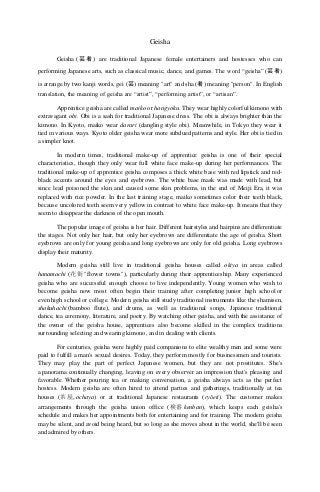B.ing xi report text geisha
•Download as DOCX, PDF•
0 likes•766 views
report text : Geisha
Report
Share
Report
Share

Recommended
More Related Content
Featured
Featured (20)
Product Design Trends in 2024 | Teenage Engineerings

Product Design Trends in 2024 | Teenage Engineerings
How Race, Age and Gender Shape Attitudes Towards Mental Health

How Race, Age and Gender Shape Attitudes Towards Mental Health
AI Trends in Creative Operations 2024 by Artwork Flow.pdf

AI Trends in Creative Operations 2024 by Artwork Flow.pdf
Content Methodology: A Best Practices Report (Webinar)

Content Methodology: A Best Practices Report (Webinar)
How to Prepare For a Successful Job Search for 2024

How to Prepare For a Successful Job Search for 2024
Social Media Marketing Trends 2024 // The Global Indie Insights

Social Media Marketing Trends 2024 // The Global Indie Insights
Trends In Paid Search: Navigating The Digital Landscape In 2024

Trends In Paid Search: Navigating The Digital Landscape In 2024
5 Public speaking tips from TED - Visualized summary

5 Public speaking tips from TED - Visualized summary
Google's Just Not That Into You: Understanding Core Updates & Search Intent

Google's Just Not That Into You: Understanding Core Updates & Search Intent
The six step guide to practical project management

The six step guide to practical project management
Beginners Guide to TikTok for Search - Rachel Pearson - We are Tilt __ Bright...

Beginners Guide to TikTok for Search - Rachel Pearson - We are Tilt __ Bright...
B.ing xi report text geisha
- 1. Geisha Geisha ( 芸 者 ) are traditional Japanese female entertainers and hostesses who can performing Japanese arts, such as classical music, dance, and games. The word “geisha” (芸者) is arrange by two kanji words, gei (芸) meaning "art" and sha (者) meaning "person". In English translation, the meaning of geisha are “artist”, “performing artist”, or “artisan”. Apprentice geisha are called maiko or hangyoku. They wear highly colorful kimono with extravagant obi. Obi is a sash for traditional Japanese dress. The obi is always brighter than the kimono. In Kyoto, maiko wear darari (dangling style obi). Meanwhile, in Tokyo they wear it tied in various ways. Kyoto older geisha wear more subdued patterns and style. Her obi is tied in a simpler knot. In modern times, traditional make-up of apprentice geisha is one of their special characteristics, though they only wear full white face make-up during her performances. The traditional make-up of apprentice geisha composes a thick white base with red lipstick and red- black accents around the eyes and eyebrows. The white base mask was made with lead, but since lead poisoned the skin and caused some skin problems, in the end of Meiji Era, it was replaced with rice powder. In the last training stage, maiko sometimes color their teeth black, because uncolored teeth seem very yellow in contrast to white face make-up. It means that they seem to disappear the darkness of the open mouth. The popular image of geisha is her hair. Different hairstyles and hairpins are differentiate the stages. Not only her hair, but only her eyebrows are differentiate the age of geisha. Short eyebrows are only for young geisha and long eyebrows are only for old geisha. Long eyebrows display their maturity. Modern geisha still live in traditional geisha houses called okiya in areas called hanamachi (花街 "flower towns"), particularly during their apprenticeship. Many experienced geisha who are successful enough choose to live independently. Young women who wish to become geisha now most often begin their training after completing junior high school or even high school or college. Modern geisha still study traditional instruments like the shamisen, shakuhachi (bamboo flute), and drums, as well as traditional songs, Japanese traditional dance, tea ceremony, literature, and poetry. By watching other geisha, and with the assistance of the owner of the geisha house, apprentices also become skilled in the complex traditions surrounding selecting and wearing kimono, and in dealing with clients. For centuries, geisha were highly paid companions to elite wealthy men and some were paid to fulfill a man's sexual desires. Today, they perform mostly for businessmen and tourists. They may play the part of perfect Japanese women, but they are not prostitutes. She's a panorama continually changing, leaving on every observer an impression that's pleasing and favorable. Whether pouring tea or making conversation, a geisha always acts as the perfect hostess. Modern geisha are often hired to attend parties and gatherings, traditionally at tea houses (茶屋, ochaya) or at traditional Japanese restaurants (ryōeti). The customer makes arrangements through the geisha union office (検番 kenban), which keeps each geisha's schedule and makes her appointments both for entertaining and for training. The modern geisha may be silent, and avoid being heard, but so long as she moves about in the world, she'll be seen and admired by others.
- 2. Source : http://en.wikipedia.org/wiki/Geisha http://www.oprah.com/oprahshow/Inside-the-World-of-Geisha#ixzz2bwqNI100 http://www.wunrn.com/news/2010/02_10/02_22_10/022210_japan.htm Kelompok … Anggota : Amelia Margaretha XI IA 6 / 08 Natalia Rinka XI IA 6 / 15 Natalia Vincentia XI IA 6 / 29 Rahel Moudy XI IA 6 / 30
